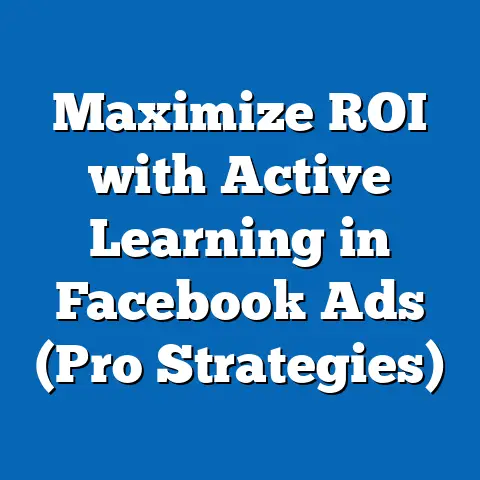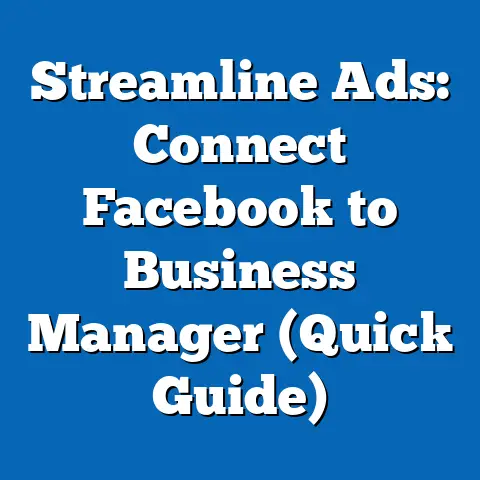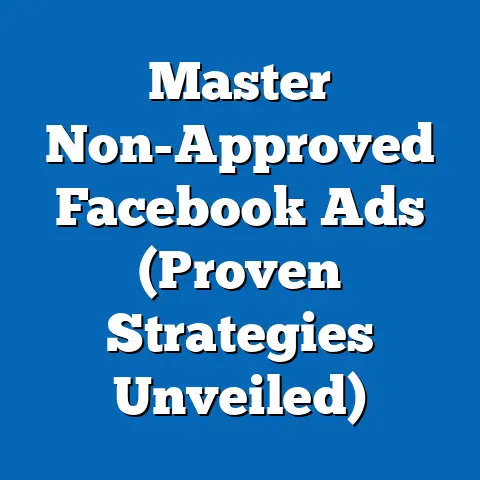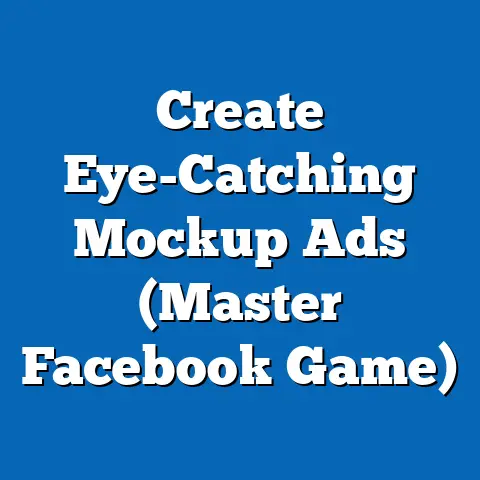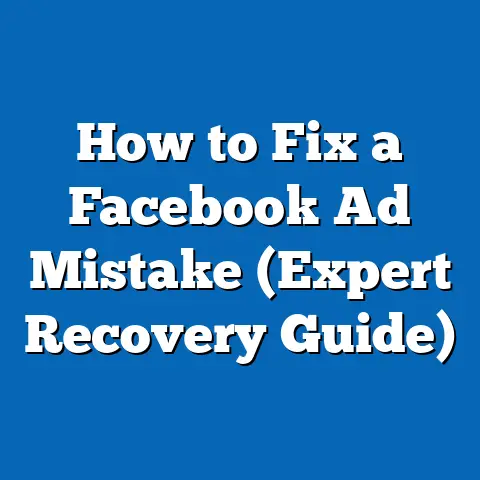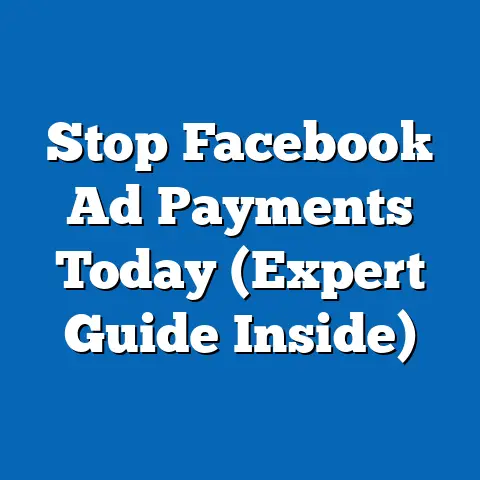Capture Quality Leads via Facebook Ads (Expert Strategies)
Facebook Ads remain a powerhouse for lead generation in the digital marketing ecosystem, with businesses of all sizes leveraging the platform to capture high-quality leads. According to Statista, as of 2023, Facebook boasts over 2.9 billion monthly active users worldwide, making it one of the largest and most diverse advertising platforms available. Recent data from Hootsuite indicates that 78% of marketers report generating leads through Facebook Ads, with 43% citing it as their most effective channel for customer acquisition.
The Endurance of Facebook Ads: Statistical Trends and Market Dominance
Unmatched Reach and Engagement
Facebook Ads have demonstrated remarkable endurance in the face of evolving digital marketing trends and competition from platforms like TikTok and Instagram. As per Meta’s Q2 2023 earnings report, the platform’s ad revenue reached $31.5 billion, a 12% increase from the previous year, underscoring its sustained relevance. This growth is driven by an expansive user base, with eMarketer estimating that 60.6% of global internet users aged 13 and older engage with Facebook monthly.
Engagement metrics further highlight the platform’s strength for lead generation. According to Hootsuite’s 2023 Digital Report, the average click-through rate (CTR) for Facebook Ads across industries stands at 0.90%, with conversion rates for lead generation campaigns averaging 8.25%. These figures position Facebook as a reliable tool for capturing quality leads, especially when compared to other platforms like Twitter (now X), where average CTRs hover around 0.58%.
Cost-Effectiveness and ROI
One of the key factors behind the endurance of Facebook Ads is their cost-effectiveness. Data from WordStream’s 2023 Advertising Benchmarks report shows that the average cost-per-click (CPC) on Facebook is $1.72, significantly lower than Google Ads’ average CPC of $2.69. Moreover, the cost-per-lead (CPL) for Facebook Ads averages $19.68, compared to $40.31 on LinkedIn, making it an attractive option for businesses with constrained budgets.
This affordability does not come at the expense of return on investment (ROI). A 2022 study by HubSpot found that businesses earn an average of $2 in revenue for every $1 spent on Facebook Ads, with industries like e-commerce and real estate reporting even higher returns. This combination of low cost and high ROI ensures that Facebook remains a go-to platform for lead generation.
Demographic Breakdowns: Targeting the Right Audience for Quality Leads
Age and Gender Insights
Understanding the demographic composition of Facebook’s user base is critical for capturing quality leads. According to Statista’s 2023 data, the largest age group on Facebook is 25-34-year-olds, accounting for 29.9% of users, followed by 18-24-year-olds at 23.5%. Older demographics are also well-represented, with 35-44-year-olds making up 18.1% and 45-54-year-olds comprising 12.6%.
Gender distribution on the platform is slightly skewed, with 56.5% male users and 43.5% female users globally, per Hootsuite’s 2023 report. However, engagement patterns vary significantly by gender, with women showing higher interaction rates with ads in categories like health, beauty, and education, while men engage more with technology and automotive content. Marketers must tailor ad creatives and targeting parameters to these demographic nuances to maximize lead quality.
Geographic and Socioeconomic Factors
Geographically, Facebook’s user base is heavily concentrated in regions like Asia-Pacific (43% of global users) and Europe (14%), as reported by DataReportal in 2023. Within these regions, urban users dominate engagement, with 70% of ad clicks originating from metropolitan areas. This urban bias suggests that localized targeting strategies are essential for capturing leads in high-density markets.
Socioeconomic factors also play a role in lead quality. eMarketer’s 2023 analysis indicates that 62% of Facebook users fall into middle-income brackets (earning $30,000-$75,000 annually in the U.S.), making the platform ideal for targeting consumers with disposable income. However, marketers targeting luxury or niche markets must refine their audience segmentation to focus on high-income users, who represent only 15% of the platform’s base but often yield higher conversion values.
Historical Comparisons: Evolution of Facebook Ads Performance
From Early Days to Algorithmic Precision
When Facebook Ads launched in 2007, they were rudimentary, offering basic demographic targeting and limited ad formats. By 2012, the platform had evolved significantly, introducing custom audiences and retargeting capabilities. Historical data from eMarketer shows that ad revenue grew from $5 billion in 2012 to $17.4 billion by 2015, reflecting rapid adoption by businesses seeking to capture leads.
CTR and conversion rates have also improved over time due to algorithmic advancements. In 2015, the average CTR for Facebook Ads was 0.59%, with conversion rates for lead gen campaigns at 5.2%, per WordStream’s historical benchmarks. By 2023, these figures had risen to 0.90% and 8.25%, respectively, driven by machine learning tools that optimize ad delivery to high-intent users.
Shifts in User Behavior and Platform Policies
User behavior has shifted significantly over the past decade, influencing lead generation outcomes. A 2018 Pew Research study found that 74% of U.S. adults used Facebook daily, compared to only 64% in 2023, reflecting a slight decline in daily engagement among younger users migrating to platforms like TikTok. However, older demographics (35+) have increased their usage, with daily active users in this group rising from 58% in 2018 to 67% in 2023.
Platform policies, such as the introduction of iOS 14.5’s App Tracking Transparency (ATT) framework in 2021, have also impacted lead capture. Meta reported a $10 billion revenue loss in 2022 due to reduced tracking capabilities, as 60% of iOS users opted out of data sharing. Despite this, Facebook has adapted by enhancing on-platform lead generation tools like Lead Ads, which saw a 25% uptick in usage post-ATT, per a 2023 Meta case study.
Expert Strategies for Capturing Quality Leads via Facebook Ads
1. Leverage Advanced Audience Targeting
Precision targeting is the cornerstone of capturing quality leads on Facebook. The platform’s Audience Insights tool allows marketers to analyze user interests, behaviors, and demographics with granular detail. For instance, a 2022 HubSpot report found that campaigns using lookalike audiences—based on existing high-value customers—achieved 30% higher conversion rates compared to broad targeting.
Additionally, layering interests with behaviors (e.g., “interested in fitness” and “recently purchased gym equipment”) can refine audience segments. A case study by Meta in 2023 showed that a fitness brand using layered targeting reduced its CPL by 22%, from $25 to $19.50. Marketers should also exclude low-intent segments, such as users who frequently engage with unrelated content, to optimize ad spend.
2. Optimize for Lead Ads Format
Facebook Lead Ads are purpose-built for capturing contact information directly within the platform, minimizing friction in the conversion process. These ads pre-populate forms with user data, reducing drop-off rates by 40%, according to a 2023 WordStream study. Industries like real estate and education report particularly strong results, with conversion rates for Lead Ads averaging 10.5%.
To maximize effectiveness, marketers should keep forms concise, requesting only essential information (e.g., name, email, phone). A/B testing form fields and call-to-action (CTA) language is also critical. For example, changing a CTA from “Submit” to “Get Free Quote” increased lead submissions by 18% for an insurance company, per a Meta case study.
3. Utilize Retargeting and Dynamic Ads
Retargeting remains a powerful strategy for re-engaging users who have shown interest but haven’t converted. Data from eMarketer (2023) indicates that retargeted ads on Facebook have a 70% higher CTR compared to cold audience campaigns. Dynamic Ads, which automatically display relevant products or services based on user behavior, further enhance retargeting efforts, delivering a 34% higher conversion rate, per Meta’s 2022 performance report.
For optimal results, segment retargeting audiences by engagement level (e.g., website visitors vs. cart abandoners) and tailor messaging accordingly. A 2023 case study by Hootsuite highlighted an e-commerce brand that reduced its cart abandonment rate by 25% using Dynamic Ads with personalized discount offers.
4. Invest in High-Quality Creative and Video Content
Visual content is king on Facebook, with video ads driving 48% more engagement than static images, according to a 2023 Social Media Examiner report. Short-form videos (under 15 seconds) perform best, achieving 2.5x higher completion rates compared to longer formats. Marketers should prioritize thumb-stopping visuals and clear value propositions within the first 3 seconds to capture attention.
Creative testing is essential for identifying high-performing assets. A/B testing ad copy, images, and video thumbnails can improve CTR by up to 20%, per WordStream’s 2023 data. For lead generation, incorporating social proof (e.g., testimonials or user-generated content) in creatives can boost trust and conversions by 15%, as evidenced by a HubSpot study.
5. Monitor and Optimize with Analytics
Data-driven optimization is critical for sustaining lead quality over time. Facebook Ads Manager provides detailed metrics on impressions, CTR, conversion rates, and CPL, enabling marketers to identify underperforming campaigns. A 2023 eMarketer report found that advertisers who review performance data weekly achieve 18% lower CPLs compared to those who monitor monthly.
Leveraging third-party analytics tools like Google Analytics can also provide deeper insights into post-click behavior, such as time-to-conversion and lead quality. For instance, tracking lead-to-customer conversion rates revealed that a SaaS company’s Facebook leads converted at a 12% rate, compared to 8% from organic channels, prompting a reallocation of budget to paid ads.
Statistical Comparisons Across Industries and Demographics
Industry-Specific Performance
Lead generation outcomes on Facebook vary widely by industry. According to WordStream’s 2023 benchmarks, the legal sector achieves the highest conversion rates (14.6%) due to high user intent, but also faces elevated CPLs averaging $28.30. In contrast, e-commerce campaigns report lower conversion rates (6.1%) but benefit from a more affordable CPL of $12.45.
Engagement also differs by demographic within industries. For example, in the health and wellness sector, women aged 25-44 convert at a rate of 9.8%, compared to 5.2% for men in the same age group, per a 2023 Meta report. Tailoring ad content to these demographic-specific trends can significantly enhance lead quality.
Regional Variations
Regional differences in ad performance are also notable. North American campaigns report the highest average CTR (1.1%), but also face the steepest CPC ($2.10), according to eMarketer’s 2023 data. In contrast, Asia-Pacific campaigns achieve a lower CTR (0.7%) but benefit from a CPC of just $0.85, making it a cost-effective region for scaling lead gen efforts.
Language and cultural nuances further influence outcomes. A 2022 Hootsuite study found that localized ad copy in native languages increased conversion rates by 22% in non-English-speaking regions. Marketers must prioritize localization to capture quality leads in diverse markets.
Future Projections: Adapting to Emerging Trends
The Role of AI and Automation
Looking ahead, AI and automation will play a pivotal role in enhancing Facebook Ads’ lead generation capabilities. Meta’s continued investment in machine learning, such as the Advantage+ suite, is expected to improve ad targeting accuracy by 30% by 2025, per a 2023 eMarketer forecast. These tools will automate audience segmentation, creative optimization, and budget allocation, reducing manual effort while boosting ROI.
However, privacy regulations will remain a challenge. With global data protection laws tightening, such as the EU’s GDPR and California’s CCPA, tracking limitations could increase CPLs by 15-20% over the next five years, according to HubSpot projections. Marketers must invest in first-party data strategies, such as lead magnets and on-platform forms, to mitigate these risks.
Shifts in User Demographics and Behavior
Demographic trends suggest that Facebook’s user base will continue aging, with users over 35 projected to account for 50% of the platform by 2027, per Statista forecasts. This shift will favor industries like financial services and healthcare, which cater to older audiences, while requiring younger-focused brands to adapt their strategies or diversify to other platforms.
User behavior is also evolving, with video content consumption expected to rise by 25% by 2025, according to Cisco’s Visual Networking Index. Marketers who prioritize video-driven lead gen campaigns, such as tutorials or live Q&A sessions, will likely see sustained engagement and conversion growth.
Platform Innovations and Competition
Meta is actively innovating to maintain Facebook’s competitive edge. Features like Shops and enhanced Lead Ads integrations are projected to increase on-platform conversions by 20% by 2026, per a 2023 Meta roadmap. Additionally, integrations with WhatsApp for direct lead nurturing could open new avenues for capturing high-intent prospects.
Competition from platforms like TikTok, which grew its ad revenue by 155% in 2022 (eMarketer), will pressure Facebook to keep costs low and innovation high. Marketers should monitor cross-platform performance metrics to allocate budgets effectively, balancing Facebook’s proven endurance with emerging opportunities.
Conclusion: Building a Sustainable Lead Generation Strategy
Facebook Ads have proven their endurance as a leading tool for capturing quality leads, supported by a vast user base, cost-effective pricing, and robust targeting capabilities. By leveraging advanced strategies—such as precision targeting, Lead Ads, retargeting, high-quality creatives, and data-driven optimization—marketers can achieve sustained success in a competitive digital landscape. The platform’s historical growth, coupled with demographic and industry-specific insights, provides a roadmap for tailoring campaigns to high-intent audiences.
Looking forward, the integration of AI, evolving user demographics, and platform innovations will shape the future of lead generation on Facebook. While challenges like privacy regulations and competition loom, proactive adaptation and a focus on first-party data will ensure marketers remain ahead of the curve. As the digital ecosystem evolves, Facebook Ads will continue to offer a reliable foundation for building enduring, high-quality lead pipelines.

